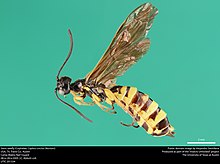| Cephus cinctus | |
|---|---|

| |
| Scientific classification | |
| Domain: | Eukaryota |
| Kingdom: | Animalia |
| Phylum: | Arthropoda |
| Class: | Insecta |
| Order: | Hymenoptera |
| Family: | Cephidae |
| Genus: | Cephus |
| Species: | C. cinctus |
| Binomial name | |
| Cephus cinctus Norton, 1872 | |
Cephus cinctus, also known as wheat stem sawfly, is a slow flying, yellow and black coloured, destructive pest found mainly in western North America.
Habit and habitat
Wheat stem sawflies grow to a length of 7 to 12 mm, with males being smaller than females. The body is black with yellow bands on the abdomen, the wings are smoke-coloured and the legs are yellow.
Life cycle
After mating, female wasps lay eggs in plant stems, usually before the grass head has emerged. Unfertilised eggs hatch into male larvae while fertilised eggs hatch into females. Larvae feed on the parenchyma of the stem. When a larva matures, it moves to the bottom of the stem and cuts a notch or groove around the inner circumference of the stem. In autumn, the larva plugs the exposed end of the stem and builds a cocoon in which it overwinters. In the following spring, it moves to the pupal stage. Adults emerge from stems to mate and begin the cycle again.
Pest status
The species has a wide host range that includes all large-stemmed grasses except oats (Avena sativa). Specifically, it feeds on wheat (Triticum aestivum), durum (T. durum), barley (Hordeum vulgare), rye (Secale cereale), wheatgrass (Agropyron spp.), timothy (Phleum spp.), Elymus spp. and cheatgrass (Bromus tectorum).
Cephus cinctus reduces yields by reducing head weight, grain quality and protein content, shrivelling seeds, and causing lodging of stems (which reduces harvest efficiency).
Because most of the life cycle occurs inside plants, insecticides are ineffective against this species.
Distribution
It is known as a chronic pest in Northern Great Plains of the United States and also an important pest of wheat in the Canadian Prairies. The species is distributed widely in various regions of the US and Canada. However, the species is believed to originate from northeastern Asia.
Genome
The genome of this species has been studied. 86% of its proteins have identifiable orthologs in other insects. It has several gene lineages not present in the more advanced Apocrita (wasps, bees and ants), such as genes for carbon dioxide receptors. It also has some expansions of chemoreceptor genes, which may be adaptations to new grasses such as wheat.
References
- "Animal Diversity Web". University of Michigan, Museum of Zoology.
- ^ "Sawflies: the wheat stem sawfly Cephus Cinctus and relatives" (PDF). Archived from the original (PDF) on 2013-11-05. Retrieved 2013-11-05.
- ^ "Diagnostic Methods for Wheat-stem sawfly". plant biosecurity ToolBox. Archived from the original on 2011-04-23.
- Clarke, John M.; DeAmbrogio, Enzo; Hare, Raymond A.; Roumet, Pierre (2012), "Genetics and Breeding of Durum Wheat", Durum Wheat, Elsevier, pp. 15–36, doi:10.1016/b978-1-891127-65-6.50007-6, ISBN 978-1-891127-65-6, retrieved 2024-05-30
- Cárcamo, Héctor; Entz, Toby; Beres, Brian (2007). "Estimating Cephus cinctus wheat stem cutting damage – can we cut stem counts?". Journal of Agricultural and Urban Entomology. 24 (3): 117–124. doi:10.3954/1523-5475-24.3.117. S2CID 86001776.
- Ivie, Michael A. (2001). "On the Geographic Origin of the Wheat Stem Sawfly (Hymenoptera: Cephidae): A New Hypothesis of Introduction from Northeastern Asia". American Entomologist. 47 (2): 84–97. doi:10.1093/ae/47.2.84. ISSN 2155-9902.
- Robertson, Hugh M; Waterhouse, Robert M; Walden, Kimberly K O; Ruzzante, Livio; Reijnders, Maarten J M F; Coates, Brad S; Legeai, Fabrice; Gress, Joanna C; Biyiklioglu, Sezgi; Weaver, David K; Wanner, Kevin W; Budak, Hikmet (2018-10-18). "Genome sequence of the wheat stem sawfly, Cephus cinctus, representing an early-branching lineage of the Hymenoptera, illuminates evolution of hymenopteran chemoreceptors". Genome Biology and Evolution. doi:10.1093/gbe/evy232. ISSN 1759-6653. PMC 6250288. PMID 30335145.
Further reading
- Holmes, N. D. (1977). "The effect of the wheat stem sawfly, Cephus cinctus (Hymenoptera: Cephidae), on the yield and quality of wheat". The Canadian Entomologist. 109 (12): 1591–1598. doi:10.4039/ent1091591-12.
- Holmes, N. D. (1982). "Population dynamics of the wheat stem sawfly, Cephus cinctus (Hymenoptera: Cephidae), in wheat". The Canadian Entomologist. 114 (9): 775–788. doi:10.4039/ent114775-9.
- Holmes, N. D.; Peterson, L. K. (1961). "Resistance of Spring Wheats to the Wheat Stem Sawfly, Cephus cinctus Nort. (Hymenoptera: Cephidae): I. Resistance to the Egg". The Canadian Entomologist. 93 (4): 250–260. doi:10.4039/ent93250-4.
- RJ, Bartelt; et al. (Feb 2002). "Cuticular hydrocarbons and novel alkenediol iacetates from wheat stem sawfly (Cephus cinctus): natural oxidation to pheromone components". Journal of Chemical Ecology. 28 (2): 385–405. doi:10.1023/A:1017994410538. PMID 11925075. S2CID 23997688.
| Taxon identifiers | |
|---|---|
| Cephus cinctus | |